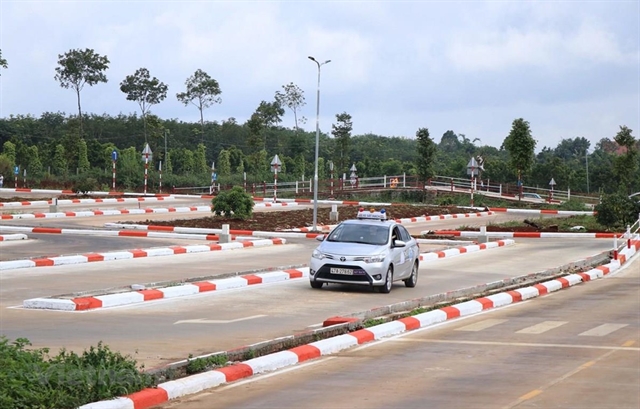 Expat Corner
Expat Corner

In many countries, passing one’s driving test is a rite of passage, on par with graduation or being able to vote.
by Ollie Arci
In many countries, passing one’s driving test is a rite of passage, on par with graduation or being able to vote.

|
| Lot to learn: Improvements in driver training could save lives. VNA/VNS Photo Ngọc Minh |
Whether it’s at age 17 in the UK, 18 in Việt Nam, or as young as 14 in some US states, receiving that plastic card opens up new avenues of freedom both in work and leisure.
But with the power of the automobile comes great responsibility. This is evident in the arduous process of learning to drive. With hundreds of hours behind the wheel alongside your instructor, thousands of pounds spent and experience driving in all kinds of road conditions, the passing of the driving test is no easy journey. For many, the process can take years, with multiple failed attempts before they are finally allowed control of a car on their own.
The Directorate for Roads of Việt Nam (DRVN) has recently moved to increase the number of questions involved in the theoretical portion of the country’s theory test from 450 to 600, in a bid to improve awareness over the legal regulations on driving in the country and improve safety.
While increasing the difficulty of the test is one way to raise the quality of the candidates awarded licences, it doesn’t necessarily translate to better drivers. In fact, the increase in questions has coincided with a spike in attempts at cheating, either through buying fake driving licenses online or the use of technology to help learners sail through the exam. In response, the DRVN has said anyone found to have cheated faces a 5-year driving ban.
But it is skills, not licences, that make for better drivers. And those that pass their driving test are just as likely to commit violations on the road.

|
| Easy driver: A learner drives with her instructor. Photo dayhoclaixe.edu.vn |
Reports last year revealed many driving centres in HCM City were ignoring rules and encouraging learners to pay extra to guarantee them a passing grade. It’s clear that in these cases drivers will lack the necessary skills once they’re out on the road, putting themselves and other road users at risk.
Driven to distraction
Approximately 8,000 people lose their lives each year in Việt Nam as a result of road traffic accidents, meaning that the country sees an average of 23 deaths every day. The World Health Organization estimates that road traffic injuries are the leading cause of death for those aged between 15 and 29. Indeed, the young are most at risk, with deaths in traffic accidents among high school students in Hà Nội reaching 7.39 per 100,000 students, almost three times higher than in Japan, and almost twice as high as in South Korea.
In comparison, the UK sees around 1,700 deaths per year on the roads. Of course, Việt Nam’s higher proportion of motorcycle use is partially to blame, with motorcyclists accounting for approximately 59% of road traffic collisions.
However, one just needs to watch a busy intersection in Hà Nội or HCM City to see a severe lack of awareness when it comes to road safety. Returning to the driving test, the most onerous part in the UK is the practical examination, with learners only allowed to take it after approximately 40 to 50 hours of on-the-road experience. This is the kind of experience that can’t be gained through written answers or driving practice on a closed track.
Let alone the risks posed by drivers who pay their way to a licence, those that pass properly are often incapable of handling the congested streets in Việt Nam’s biggest cities. What seems to be missing is respect for the road, and, more importantly, a healthy fear of the potential for an accident.
It is vital that new drivers realise the responsibility they hold, of commandeering tons of metal at deadly speeds sometimes just inches from other vehicles and pedestrians. Through lessons, learners are taught how to safely navigate various traffic situations and build up a reservoir of real-world experience they can draw on when driving on their own. However, stricter lessons are only part of the solution. After all, often the only thing standing in the way of a fatal accident is the split second reaction time of a foot on the brake.
On top of the Law on Road Traffic, the introduction of a highway code, as in the UK, would dictate the rules of the road, including required conduct, understanding of road signs and warnings, road markings and other behaviour. Of course, learners would need ample knowledge of this before they start any practical training, which should be taken under real-world conditions.
Notably, it is often those driving larger vehicles in Việt Nam that are involved in more accidents. Those driving Heavy Goods Vehicles or public buses are rarely the most conservative drivers and frequently flout the rules of the road by either speeding or overtaking other traffic inappropriately.
Making it harder to pass the test and incorporating more realistic training would not only improve the skills of drivers, meaning they respect the responsibility of owning a motor vehicle, but it would save countless lives in the process. — VNS




